
The Convair YB-60 was an American prototype bomber aircraft for the United States Air Force, canceled on 14 August 1952.

The Northrop C-19 Alpha was a series of three aircraft purchased from Northrop by the US Army Air Corps in 1931. They were slightly modified versions of the civil Northrop Alpha Type 2.

The Aeromarine 40F was an American two-seat flying-boat training aircraft produced for the US Navy and built by the Aeromarine Plane and Motor Company of Keyport, New Jersey. Fifty out of an original order for 200 were delivered before the end of World War I, with the remainder cancelled due to the armistice.
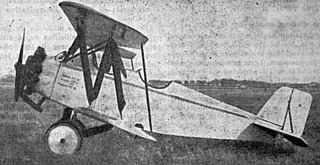
The Albatros L 68 Alauda was a two-seat German trainer aircraft of the 1920s. It was a single-engine biplane of conventional configuration that seated the pilot and instructor in tandem, open cockpits. The wings were of unequal span and had a pronounced stagger.
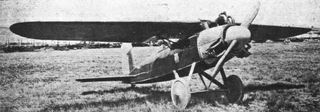
The Albatros L 69 was a two-seat German parasol monoplane racing and training aircraft of 1925. It was a single-engine parasol-wing monoplane of conventional configuration that seated the pilot and passenger in tandem, open cockpits. It was advertised as a trainer, however contemporary reports dismissed this due to the difficulty in accessing the front cockpit, and the designers' focus on performance.

The Albatros L 82 was a 1920s German trainer biplane. Of conventional configuration, it seated the pilot and instructor in separate, open cockpits. The wings were single-bay, equal-span, and unstaggered.
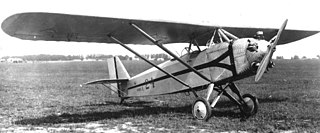
The ANBO II was a parasol-wing monoplane aircraft built in Lithuania in 1927 as a pilot trainer for the Army. It was eventually reequipped with more powerful engine for the Aero Club of Lithuania in 1931 before being written off in a crash in 1934.
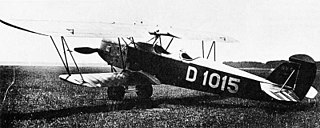
The Arado SC I was a biplane trainer developed in Germany in the 1920s. It was based on the S I, but powered by a far more powerful inline engine. Accordingly, the structure received considerable strengthening. The aircraft was intended for the clandestine military flying school at Lipetsk, but it was not accepted for this service. Instead, a small number were built for the Deutsche Verkehrsfliegerschule.
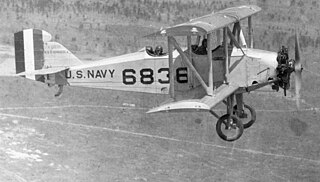
The Boeing NB was a primary training aircraft developed for the United States Navy in 1923. It was a two-bay, equal-span biplane of conventional configuration with interchangeable wheeled and float undercarriage. The pilot and instructor sat in tandem, open cockpits.

The Breda A.4 was a biplane trainer produced in Italy in the mid-1920s. It was of conventional configuration with a two-bay unstaggered wing cellule and seating for the pilot and instructor in tandem open cockpits. Apart from civil use, the A.4 was also adopted by the Regia Aeronautica as a trainer. At least some examples were produced in floatplane configuration as the A.4idro.

The Focke-Wulf S 2 was a trainer aircraft built in Germany in the late 1920s. It was a conventional parasol-wing monoplane with fixed tailskid undercarriage. The pilot and instructor sat side by side in an open cockpit. Only a single example was built.

The Fokker S.IX was a military trainer aircraft produced in the Netherlands in the mid-1930s, designed at a Royal Netherlands Navy request for a machine to replace the obsolete Fokker S.IIIs then in service. It was a conventional, single-bay biplane with staggered wings of unequal span braced with N-struts. The pilot and instructor sat in tandem, open cockpits and the undercarriage was of fixed, tailskid type with divided main units. The wing had a wooden structure, the fuselage one of welded steel tube, and the entire aircraft was fabric-covered.
The Maestranza Central de Aviación HF XX-02 was a military trainer aircraft developed in Chile in the 1950s.

The Hanriot HD.28 was a military trainer aircraft developed in France in the 1920s as a modernised version of the HD.14 for export markets. The principal difference between the types was that while the HD.14 had an entirely wooden structure, the HD.28's structure was almost entirely of metal. The landing gear was also of more conventional design, with only one wheel on each main unit, plus small anti-noseover skids. The two tandem cockpits of the HD.14 were replaced by a single, long cockpit in which both pilot and instructor sat.

The Lorraine-Hanriot LH.10 was a family of training monoplanes built in France in the early 1930s, the most widely produced and well-known member of which was the LH.16, later known simply as the Hanriot H.16. It was a conventional parasol-wing monoplane with fixed tailskid undercarriage, the main units of which were mounted on outriggers attached to the wing struts. The pilot and instructor sat in tandem open cockpits.
The Heinkel HD 21 was a trainer built in Germany during the 1920s. It was a conventional single-bay biplane with staggered wings braced with N-type interplane struts. The main units of the fixed, tailskid undercarriage were linked by a cross-axle, and the aircraft had three open cockpits in tandem, although one of these was typically faired over. The HD 29 of 1925 was essentially similar, but was purely a two-seater.
The Heinkel He 63 was a trainer biplane built in Germany in the early 1930s. It was a largely conventional design with single-bay wings, fixed tailskid undercarriage, and two open cockpits in tandem. An unusual feature of the design was the highly swept, arrow-shaped upper wing, braced to the lower wing by N-type struts. Prototypes of the He 63 were built in both landplane and seaplane form, but no production ensued.

The Sikorsky S-10 was a Russian Empiren military twin-float seaplane that served with the Baltic Fleet from the summer of 1913 to 1915. After Igor Sikorsky built the successful Sikorsky S-6 for the Russian military, he tried to build another successful aircraft for them. The S-10 was a modified S-6B built by the Russo-Baltic Carriage Factory. Approximately sixteen production versions of the S-10 were built. It had a less powerful engine and generally weaker structure than the S-6. They had either an 80 HP Gnome Monosoupape or a 100 HP Argus Motoren engine. Some were deployed on the world's first operational seaplane carriers.

The Albatros L102 / Albatros Al 102, was a German trainer aircraft of the 1930s. It was a parasol-wing landplane, seating the student pilot and instructor in separate, open cockpits. A biplane floatplane version was also built as the Al 102W, with strut-braced lower wings.

The Sikorsky S-33 Messenger was an American two-seat sesqiuplane designed and built by the Sikorsky Manufacturing Corporation in 1925.

















